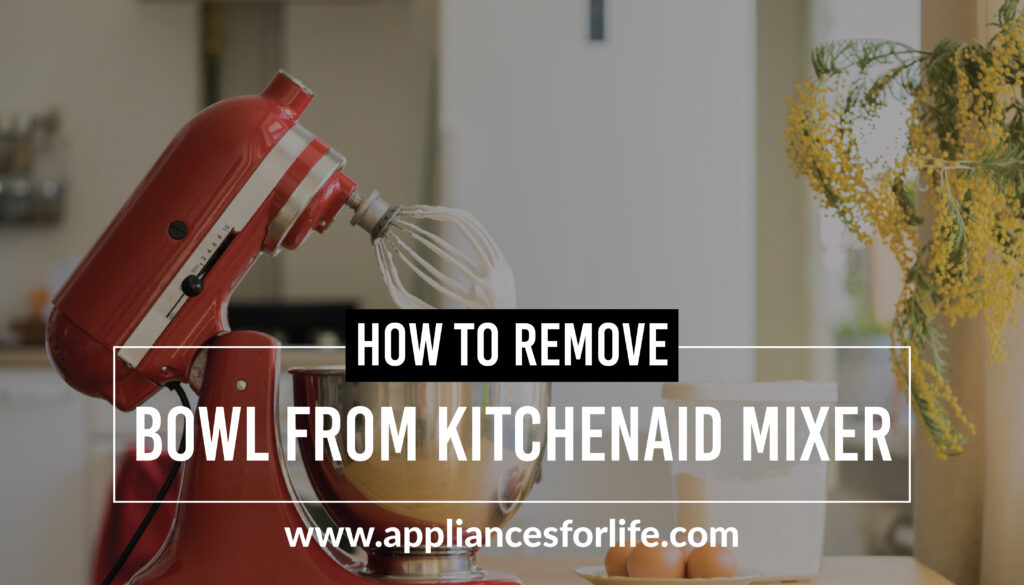- Hand mixers are a very important addition to the kitchen. Without them, you may encounter a lot of difficulties with mixing recipes like cake batters and eggs. Hand mixers come in handy when there is a need to slightly blend or combine recipes and, more importantly, make mashed potatoes.
- Without a doubt, a hand mixer offers a lot of benefits in the kitchen, and if its ‘good works are to be further enjoyed, it must be regularly maintained. Lack of maintenance and cleaning, in particular, may lead to having a bowl stuck to the mixer. When dirt is held up in the driver, the bowl may get stuck from time to time. In another case, this same situation can occur when the hand mixer overheats. This article provides further insight into why bowls get stuck to a hand mixer and how to remove it when it happens.
About KitchenAid
Table of Contents
ToggleHerbert Johnson, an engineer, working at the Hobart Corporation, first propounded the idea of a stand mixer. Herbert Johnson’s idea came from a baker’s mix dough. He was inspired by how it worked and immediately of a way to make it work even more efficiently. Hobart started manufacturing stand mixers, and later in 1917, Hobart stand mixers became standard equipment on all U.S. Navy ships, prompting development to begin on the first home models. KitchenAid mixers remained popular, and in the late 1930s, the factory would completely sell out its products each Christmas
KitchenAid is an American home appliance brand, and it is one of the subsidiaries of the Whirlpool Corporation. The KitchenAid brand was started in 1919 to build stand mixers. The first stand mixer built was the H-5 model, which was trademarked in the 1930s. Dishwashers were the second product line to be introduced by KitchenAid in 1949. A good example of a KitchenAid is the KitchenAid KSM150PSER Artisan Tilt-Head Stand Mixer.
What is a hand Mixer, and how is it used?
The term ‘hand mixer’ in the modern kitchen generally describes an electric mixing device. This electric mixing device is simply plugged into an outlet, held by the handle, and its beaters (attached to its font) are inserted into a bowl containing recipes to be mixed. A hand mixer works mostly to beat, mix, whip, and sometimes combine recipes. A hand mixer is an essential and versatile addition to the kitchen because, with this device, the difficulty of hand mixing can be totally avoided. If you have ever had to mix cake batter, you will understand how tedious it is to mix manually, however, with this device, you can do it faster and better.
“Hand mixer” may also refer to rotary non-electric egg beaters. These were kitchen essentials decades ago. Most homemakers never looked back once they were replaced with the electric version in the early 1900s.
Electric portable hand mixers are considered much more efficient than non-electric rotary egg beaters. Because they have constant power, the task of mixing requires much less time and effort. That said, rotary egg beaters are still available today. They’re quite popular among campers or in remote areas where this is no electricity. Many households still have a vintage egg beater and use it occasionally.
Hand Mixer Uses
A hand mixer can be used to mix a wide range of foods-It can be used to mix eggs, whipped creams, and boiled potatoes. This is, in fact, the best-proven method for making mashed potatoes.
Undoubtedly, hand mixers have gained a commendable reputation for their versatility in the kitchen. Even those with stand mixers still find it difficult to do away with their hand mixers because of the convenient use of a hand mixer. All you need to make a hand mixer function optimally is to insert its beaters in a bowl of recipes and swirl around for a little while.
However, it is important to learn the limitations of a hand mixer. A KitchenAid hand mixer may not be able to function with ultimate efficiency if the recipe to be mixed has a heavy consistency. Oftentimes, a hand mixer’s efficiency depends largely on its capacity and the softness of the food it is mixing. Hence, for some applications (like kneading bread dough), a more powerful stand mixer is a better choice.
How to use a hand Mixer effectively
It is important to learn how to use a hand mixer to avoid damage to the device and avoid situations where a bowl will be stuck in the hand mixer.
Do not add all ingredients at a time
Except your mixer is a very powerful kind, it is advisable to not throw in all the ingredients at once. Otherwise, this may just cause one big mess. Throwing all your ingredients at a hand mixer may suppress its spinning ability and cause it to be choked up. The hand mixer may even splash the recipes around and make a mess if the ingredients to be combined are excessive.
One of the ways to deal with this situation is to choose the highest level on your hand mixer to deal with heavy loads. Subsequent sections will address how to adjust your hand mixer’s capacity.
Learn the dynamics of your hand mixer speed.
Understanding how fast or low your hand mixer needs to spin to achieve certain functions is crucial to achieving an optimal recipe combination. Below are some tips to help you understand hand mixer speed variations
Never force a big and sudden change in speed. For example, your hand mixer is running at speed ‘1’. However, you want to see how powerful the machine is, so you suddenly change to speed ‘4’. Honestly, your mixture will 100% fly over your kitchen, and you might suffer a shock from its power. Instead, you must take 1 mode at a time to ensure consistency.
Low speeds are designed for hard ingredients
Many think that we should choose the highest level to blend hard ingredients such as cookies. Nevertheless, it is not true! In contrast, lower speeds are the best solution for this kind of food to have a good mixture as they can blend the ingredients well instead of just breaking them into pieces.
High speeds are produced for liquids
Normally, you will need the mixed liquids, for instance, eggs or heavy cream, to be smooth and relatively thick. Therefore, higher speeds come highly recommended because they will make the ingredients quickly combined and stuck to others.
Clean your mixer after use
To guarantee the durability of your hand mixer, it is necessary to maintain it. Maintenance could come in several forms, including cleaning. Cleaning your hand mixer will not only help keep it in a good working condition, but it will also guarantee your safety and longevity. Follow the steps below to give your hand mixer a good clean.
Step 1: Set the speed to zero
Step 2: Turn off the machine and unplug it from the socket. The first 2 steps here are to ensure that there will be no serious accident
Step 3: Eject the attached items from the machine
Step 4: Clean those items first, as they are always the dirtiest part. Use soap and warm water to wash them
Step 5: Use a cloth and warm water to clean the mixer body
Step 6: Wait until they get dry and then put them into the storing case
How to remove bowl from KitchenAid tilt-head and bowl-lift mixers.
Kitchenaid mixer bowl removal is not rocket science, you do not necessarily need to learn how to take a KitchenAid mixer apart before you get that bowl detached from your hand mixer. The mechanism for removing a stuck bowl in a KitchenAid mixer differs according to the type in question.
For tilt-head mixers:
Regardless of the recipe, you had just mixed. Whether it is a bread dough in your standard stainless steel bowl or you have just melted chocolate in your precision heat bowl, the process for removing the bowl from your tilt-head machine will be the same. Follow the simple steps below to remove a stuck bowl when KitchenAid bowl gets stuck;
- Slide the lever on the mixer to the unlock position and tilt back the mixer head.
- Hold the bowl with both hands. Turn the bowl anticlockwise until you feel it detach itself from the base plate. Remove it gently in a motion upwards.
For bowl-lift mixers:
- Rotate the bowl-lift handles on the sides of the mixer to the down position using the lever.
- Hold the bowl handles firmly. Now gently apply pressure and lift the bowl straight up and off the locating pins.
Why does my KitchenAid bowl get stuck?
A mixing bowl and other attachments getting stuck to a hand mixer is a common occurrence. Many first-time users panic over this before they eventually discover that disentangling a bowl stuck in a hand mixer is not a difficult task at all
The major reason why bowls get stuck in a hand mixer is logged food residue. Food particles get trapped inside the cavity of your special attachments or your bowl-lift handles when mixing is in progress, and failure to immediately remove this bowl as soon as mixing is done will cause the bowl to remain stuck for a while. However, in order to avoid your bowl getting stuck, all you need to do is keep the stand mixer clean by wiping it down with a damp cloth (remember to do this after you’ve switched off the power!) as mixing is over.
Another common culprit of a stuck bowl in a hand mixer is the heat generated from mixing. The heat generated from mixing can cause the bowl to expand, especially the metal-based ones. This then makes it difficult for the bowl to wiggle out.
How to remove a stuck KitchenAid bowl
For starters, if you resort to physical force, it is possible that you are able to get the bowl out successfully. Brute force might do the trick for a tight jar or a jammed cabinet door, but I don’t think it’s a good idea with delicate (and expensive) machines like your precious KitchenAid. The machine may eventually stop working if mishandled, and sadly, you may now have to deal with what to do when your KitchenAid hand mixer stops working. Hence, there are more efficient technical ways to get it done, and this will be treated below.
Get a sizable towel, completely immerse it in water until wet, and pull it out to wring excess water off it. Wrap this damp towel around the base of the stuck bowl and let it remain there for about 5 to 10 minutes. This process will help the steel mixing bowl to cool down and contract for some minutes. While the bowl cools down and contracts, the bowl will loosen up, then you will be able to pull it out easily.
However, if your bowl gets stuck too often, deal with this situation by applying a few drops of oil or preferably spraying vegetable oil to the bottom of the mixing bowl before you re-attach it to the mixer. After applying oil to the base plate, let it remain there for about 4-5 minutes for the oil to work wonders. When this is done, the bowl should wiggle out conveniently and clean the base thoroughly to prevent oil residue from building up.
Other Maintenance Tips for a KitchenAid hand mixer
- Check Components for Lubrication
It is necessary to regularly check the moving parts of a hand mixer to make sure that they are properly lubricated. This activity, it is regularly done, can extend the lifespan of a hand mixer. If you are wondering why it is so important to regularly check the lubrication level of your hand mixer, here is why- some parts within the mixer, such as the drive components, make up a significant part of the mixer’s cost, so replacing these will be almost as expensive as buying a new mixer. Also, very importantly, pay special attention to the lubrication around the drive, reducer, and shaft bearings especially. Set aside time once a month to check these levels.
Protect the Mixer Tub
The body of the mixer is also an important part of the proper ingredient system mixer maintenance. Whether you have a ribbon mixer, paddle mixer, or another type of mixer, the body of the machine can be damaged if the agitator is too close to the walls. Foreign objects, such as bits of metal or small rocks, can also damage the mixer as it operates.
FAQs
Why does my bowl get stuck in my hand mixer?
Bowls getting stuck in a hand mixer is, in fact, not a rare occurrence. It often happens that we think, and this sometimes happens because dirt may be holding it up. In other cases, a hand mixer gets really hot when it is being used, and the heat may cause the bowl to melt, thereby getting stuck to the hand mixer.
What are the different attachments to my hand mixer?
Hand Mixers always come with the dual beater attachment, meant for the basic jobs of whisking and mixing lighter mixtures such as pastry and creams. Some Hand Mixers also come with a set of kneading tools too. These kneading tools are used to stretch and knead heavy doughy mixtures.
How are Hand Mixers different from immersion blenders?
Hand mixers are different from immersion blenders in that they are majorly used to combine recipes as opposed to immersion blenders that are more or less like actual blenders.
21 MINUTES
ESTIMATED TIME DESIGNING AND UPLOADING THIS ARTICLE
10 HOURS 11 MINUTES
ESTIMATED TIME RESEARCHING AND WRITING THIS ARTICLE
You Might Also Like

Best Dishwasher Cleaner for Hard Water
Hard water stains are hard to combat; they can cause you a lot of trouble as well. In this article, we’ll be discussing the best dishwasher cleaners for hard water. Dishwasher, perhaps the most complicated appliance ever to be made, is quite difficult to understand.

How to Protect an Outdoor Tankless Water Heater? 10 Easy Steps
Outdoor tankless water heaters are susceptible to damage from different elements, including moisture, rain, snow, and temperature. This article explores how to protect an outdoor tankless water heater, so read to the end to learn how to best protect your precious investment. Embracing the warmth

Top 5 Tuscan Stainless Steel Appliance Package
This article will be looking at some of the best Tuscan stainless steel appliance packages. Top 5 Tuscan Stainless Steel Appliance Package Comparison Table Samsung is regarded as one of the best appliance manufacturers ever to grace the industry. The South Korean brand has

What Is More Efficient Gas or Electric Appliances
Are Gas More Efficient Than Electric Appliances Choosing household appliances can be a difficult task, most times, majorly because heating, hot water, and cooking appliances come in various forms, models, and specifications. As a matter of fact, there are also several modes by which they

Wall Air Conditioners you need to get right now
There are numerous similarities between a wall air conditioner and a window air conditioner, but the main intention of the former is not to place it on a window. Wall air conditioners are placed directly within the wall of the building. Well, if you already

4 Of The Best Kitchenaid Refrigerators on the Market
Open-box appliances are the best option for you if you are looking for top quality at a relatively cheap rate. No appliance originally is an open-box. It only becomes so after it must have been returned with some blemish found on it. Hence open box

Condensing vs Non-condensing tankless water heater
What Exactly Is a Tankless Water Heater? If you cannot associate with the group identified above, you may need to learn what tankless water is and what it does- a tankless water heater is exactly what it implies, a water heater without a tank. Traditionally,

If you need to save on space in your kitchen then a 20 inch gas range could be just what you need. Many city kitchens, apartments and other studio spaces which are tight on space need furnishing with the slimmest appliances available. Most gas ranges

How Many Appliances Can A 10000-watt Generator Run
We live under the shadow of global warming. There has been an upsurge in natural disasters that have caused power outages for several days. A 10,000-watt generator will give you enough juice to run large appliances, various tools on a job site, or many RV

Best Stovetop Gooseneck Kettle With Thermometer
Top 5 Best Stovetop Gooseneck Kettle With Thermometer Tea and coffee lovers always love to keep a kettle around, electric or stovetop. If you’re looking for a good gooseneck kettle to buy, our review of the best stovetop gooseneck kettle with a thermometer will help

